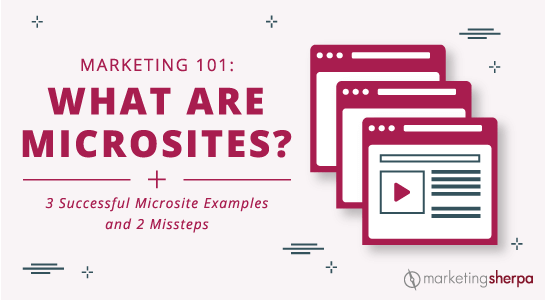Marketing 101: What are microsites? (plus 3 successful microsite examples and 2 missteps)
Marketing has a language all its own. This is our latest in a series of posts aimed at helping new marketers learn that language. What term do you find yourself explaining most often to new hires during onboarding? Let us know.
Microsites are somewhere in between a single landing page and an entire website. They are small, special-purpose websites for a single, dedicated communication (and conversion) goal set up by companies that already have a full site. They work well for the communication of an idea or product that requires more than a single landing page, for example, an event.
Successful microsite creation requires a clear goal and focus for the microsite and should be built from the ground up optimized for achieving that goal.
Here are a few tips to help you use microsites.
Tip #1: Tightly tap into visitor motivations
Microsites can be more focused on an ideal customer subset than a company’s overall website that often must serve multiple audiences. For that reason, microsites can be used to create a more forceful prospect-level value proposition.
For example, MECLABS Institute (parent organization of MarketingSherpa) was engaged in conversion marketing services for a national land and home sales organization for consumers. The company had microsites for individual communities.
In an A/B test of a community’s microsite, the control offered a community guide to prospects and used sales-oriented language like “… learn why [community name anonymized] is Paradise Found.”
The treatment offered a community map to prospects and a more helpful tone. The map was described as something that would help prospects. “Be prepared for your visit to …”
By better tapping into the motivations of people interested in visiting the community, the control produced a 326% increase in conversions.
Tip #2: Use microsites to target specific locations to garner local search
A large brand that sells warranty and car servicing options was performing well on keywords for the United Kingdom as a whole, but there were towns with service garages where the brand was off the top of the search rankings.
The team at agency DFY Links built three microsites for their client’s least competitive towns — Bath, Chepstow and Swindon. There was a similar technical setup to the main site, but with a heavy focus on the town, and the team went to work building links to these microsites every month. The team chose microsites because any increased effort to help the main site rank in certain areas would dilute the UK search and also reduce rankings in other local areas, according to Brett Downes, SEO Specialist, DFY Links.
“Within a year, Chepstow and Swindon sites featured in [spots] one to five on SERP (search engine results page) results for 90% of keywords we were targeting,” Downes said. “Bath was slightly different, as competition was higher and the other sites had a lot more backlinks. However, we did rank on page one for 50% of [keywords] we were targeting, with around 10-20% ranking in position one to three, especially on long-tail keywords.”
The sites also appeared in the local map pack, the listing of nearby businesses that appear under a map on the main SERP.
“The microsites were minimal in code and very simple. Having a lean site ensured we would have a very fast-loading website, as speed has become more of an important ranking factor (especially on mobile) this has given us the advantage [over] local, bloated sites,” Downes said.
The microsites were completely different sites, not subdomains or subfolders. Local businesses they were competing against usually had less than 50 referring domain links, so the team knew they could match the best competitors within six to nine months of link building.
“We could have used the extra budget and created subfolders on the [main] site and had targeted sections for different locations. This may have diluted the main site; plus with the microsite, the assumed location managed to qualify us for proximity searches,” he said.
However, your business may have a very different competitive mix and that can affect how you consider your URL structure, so read the next tip …











